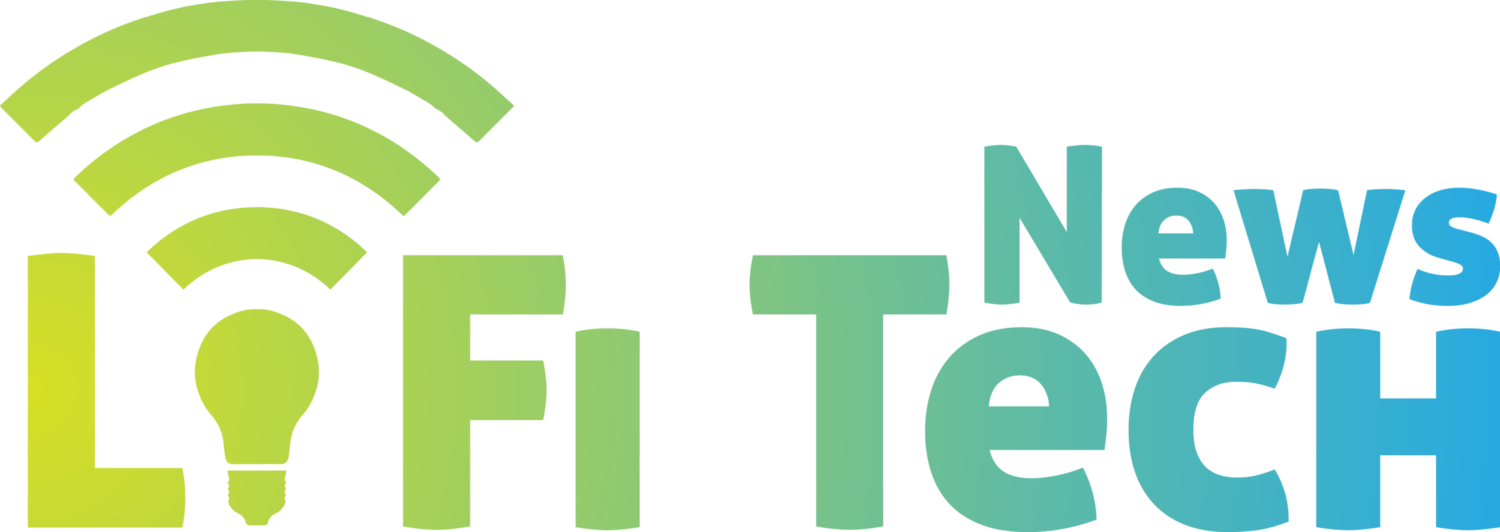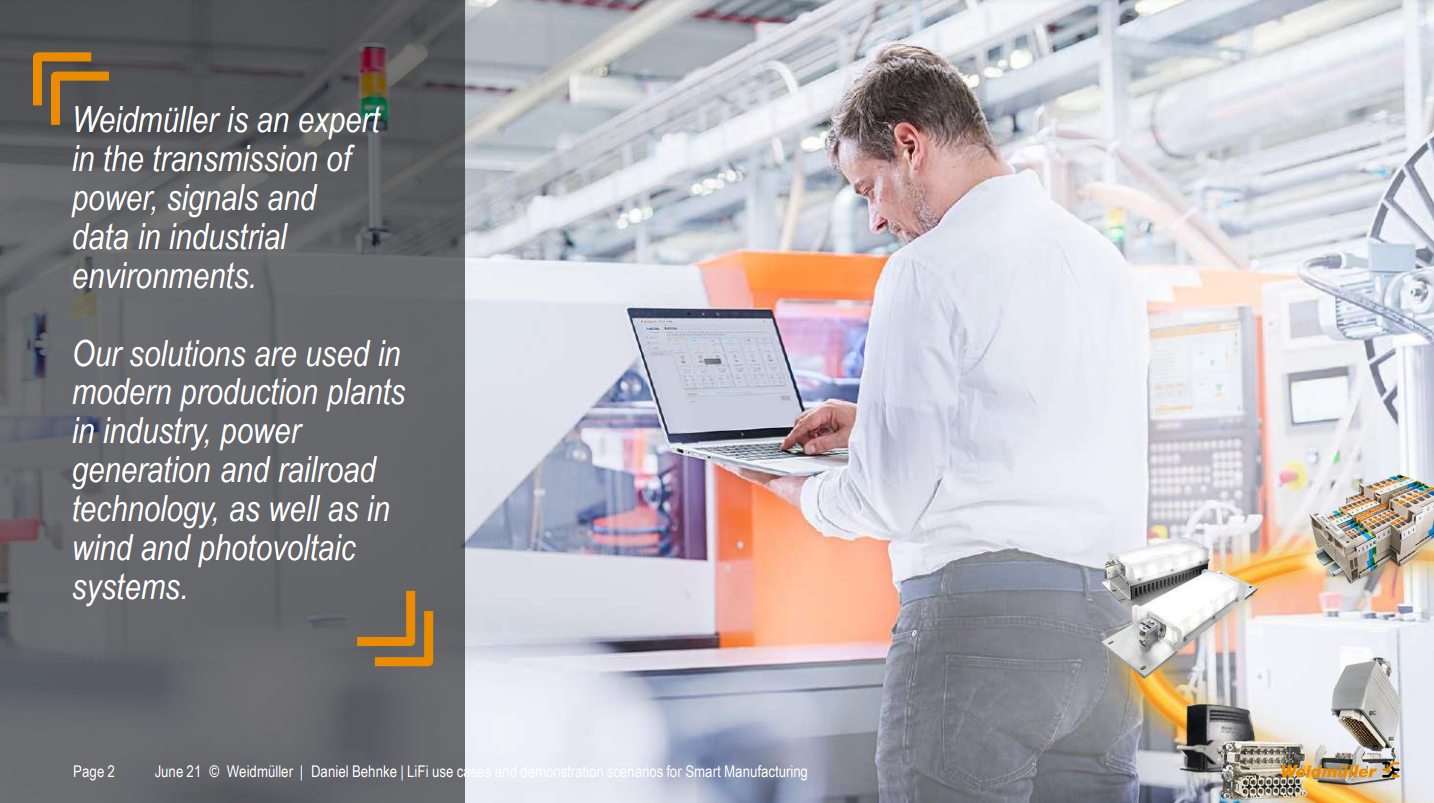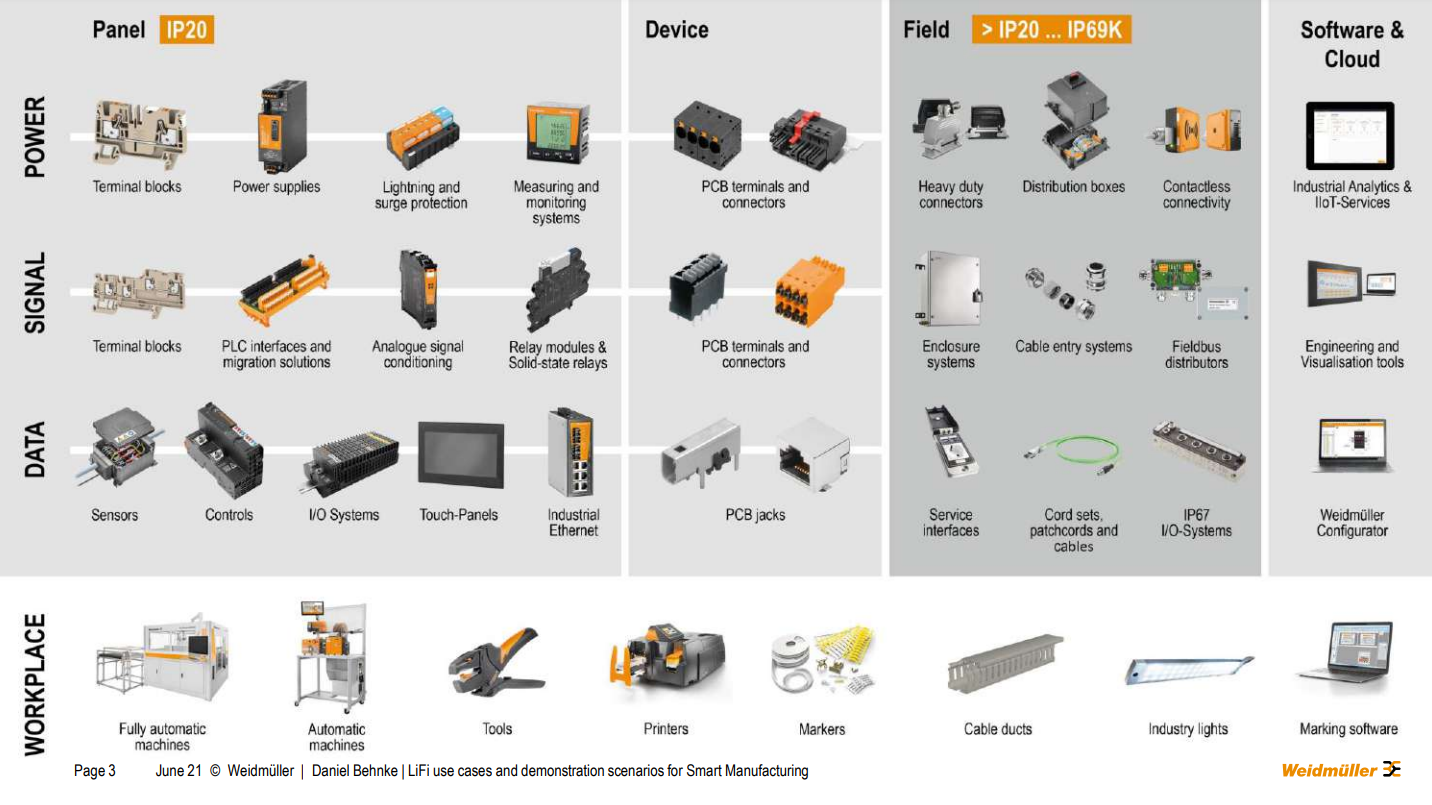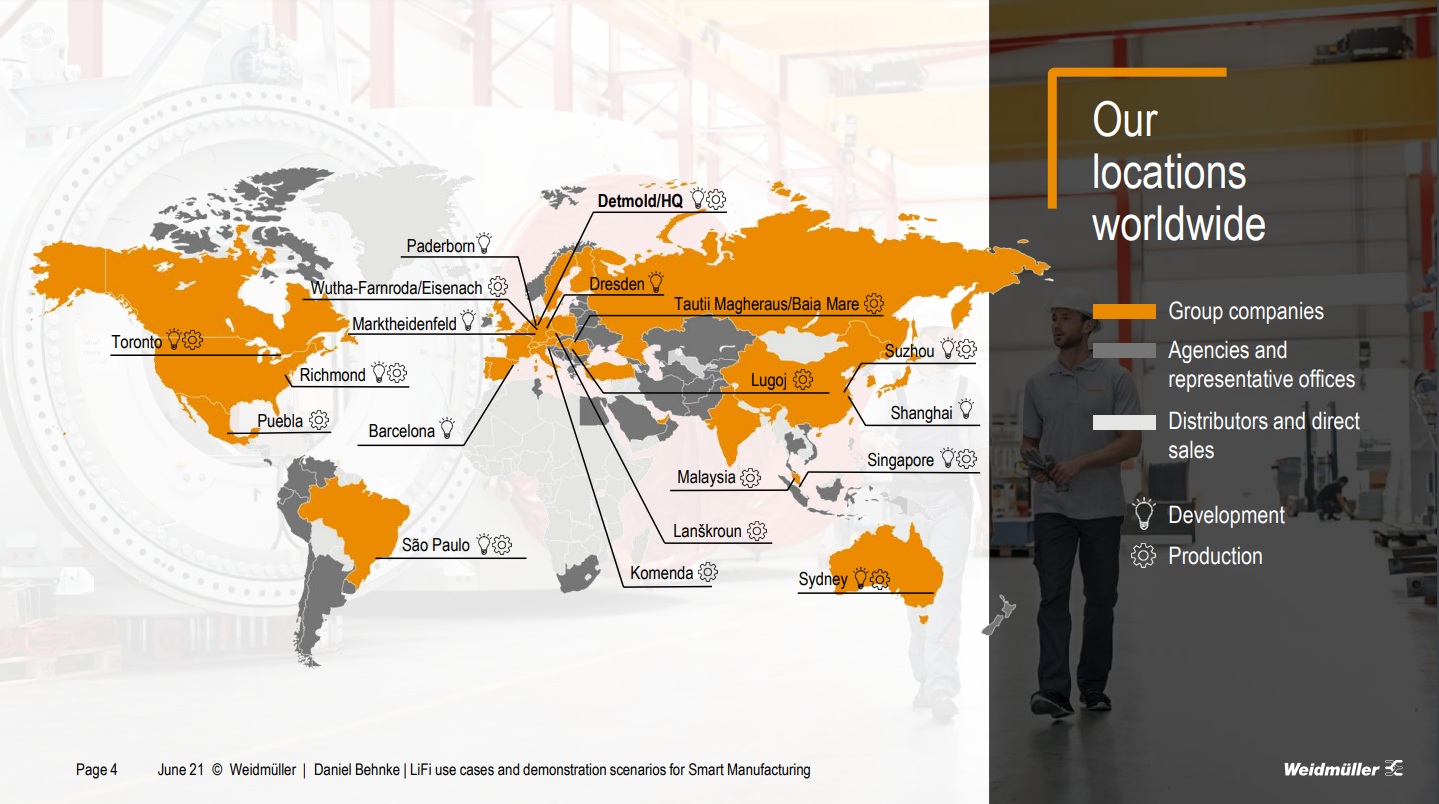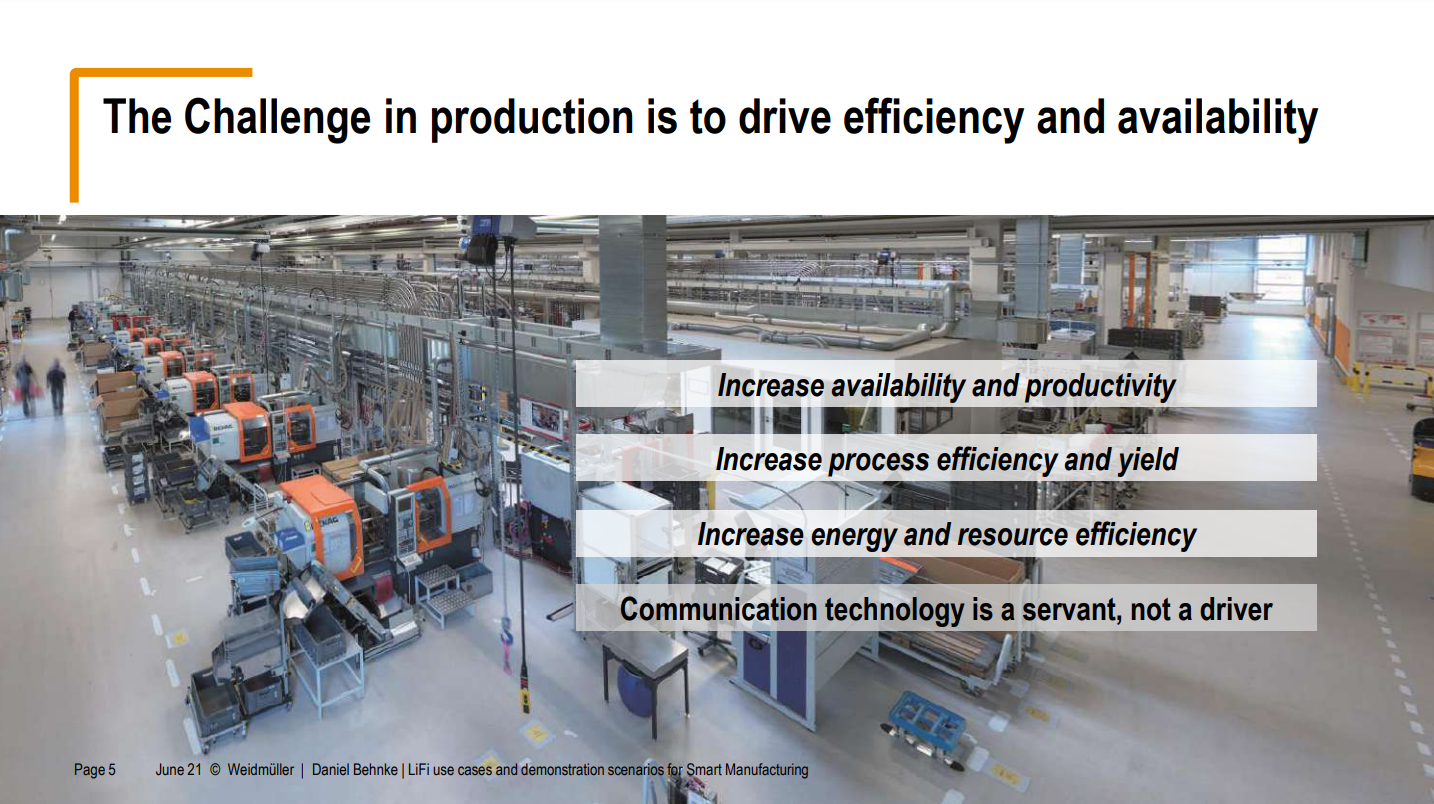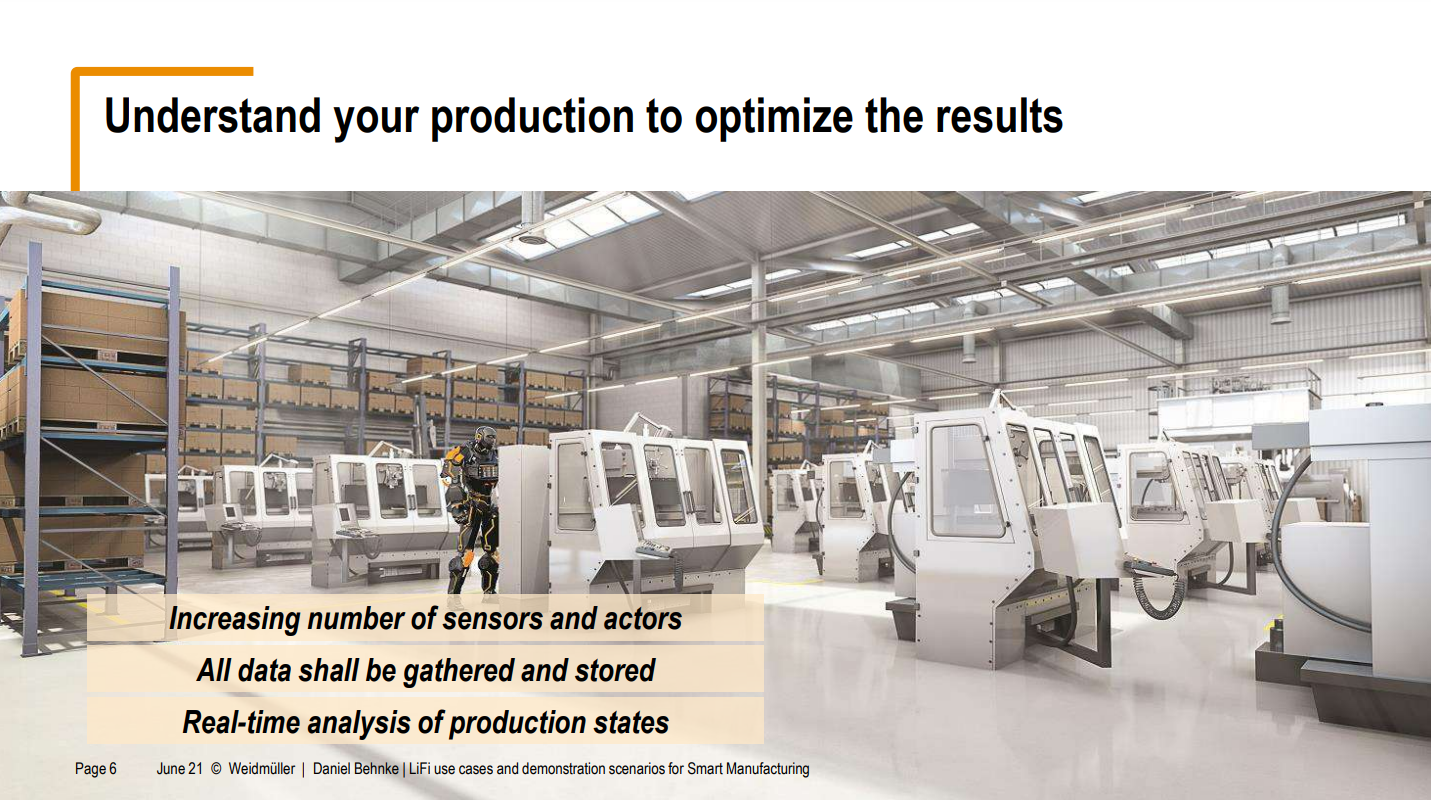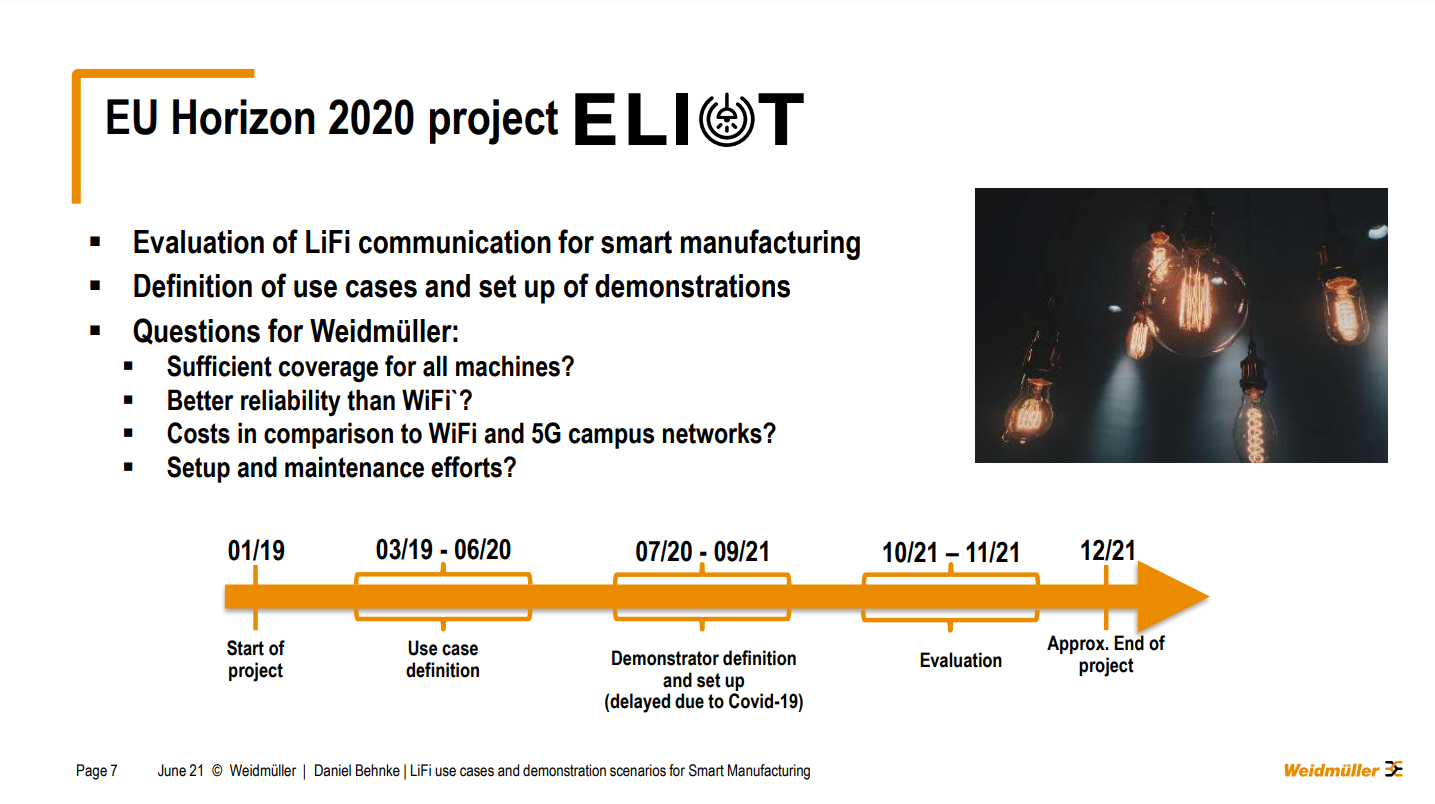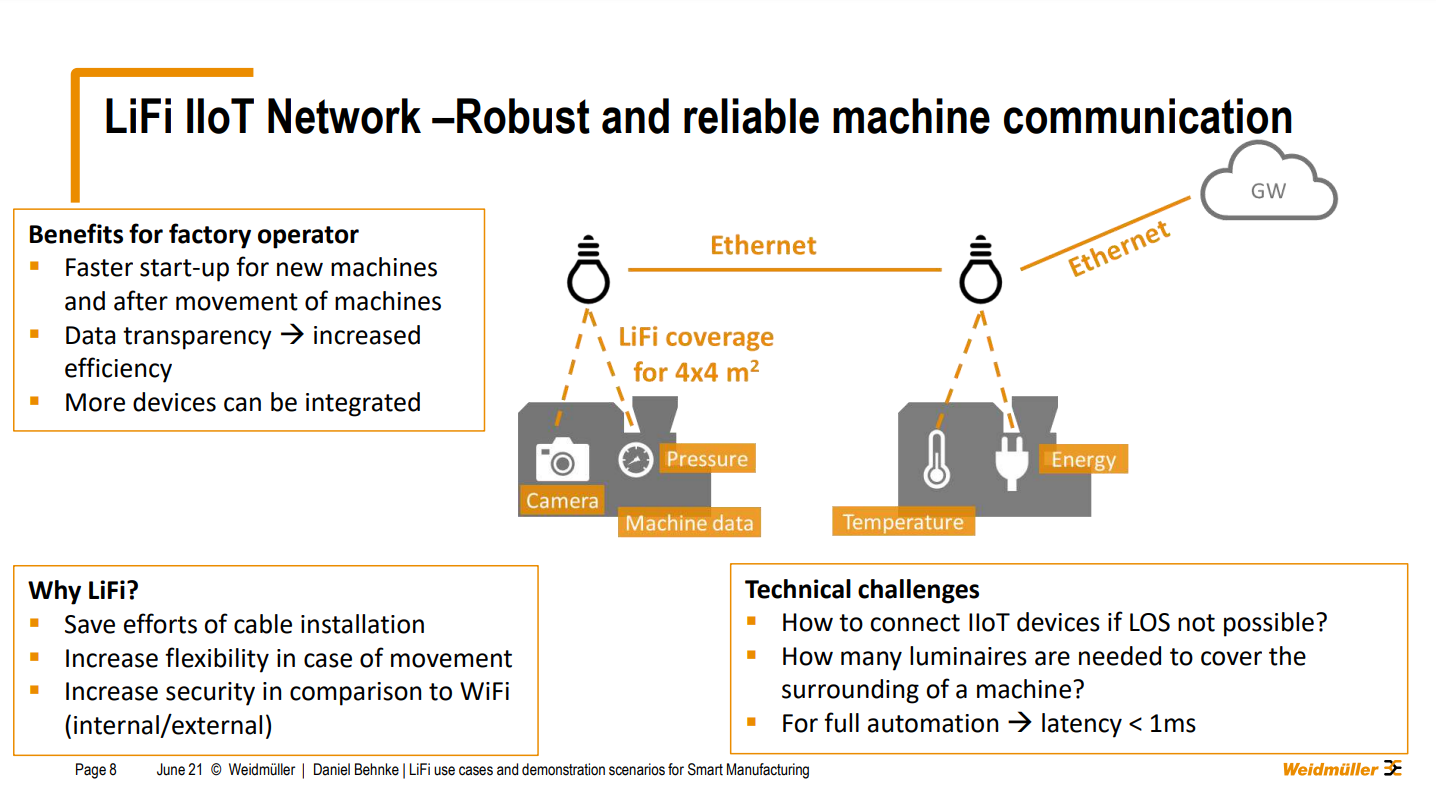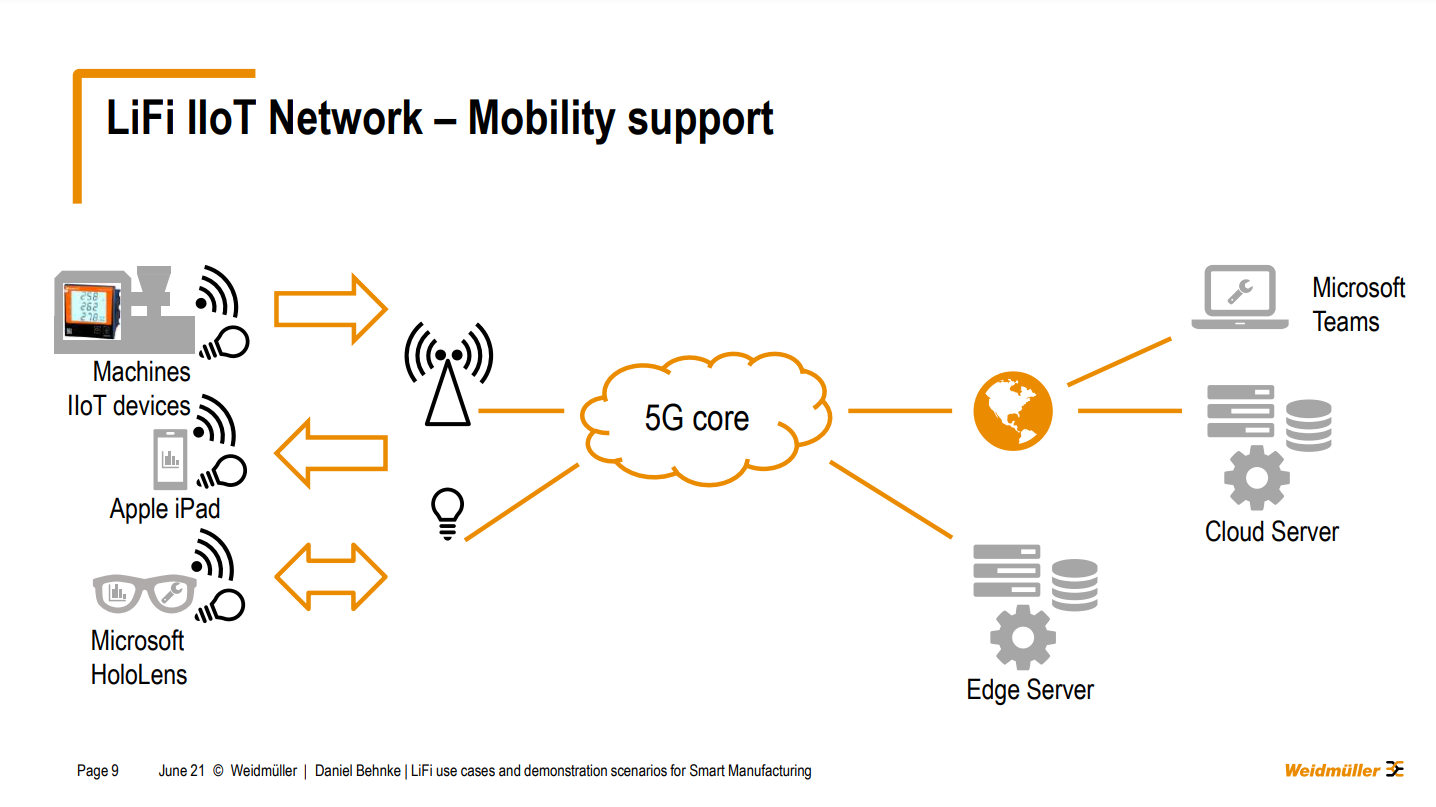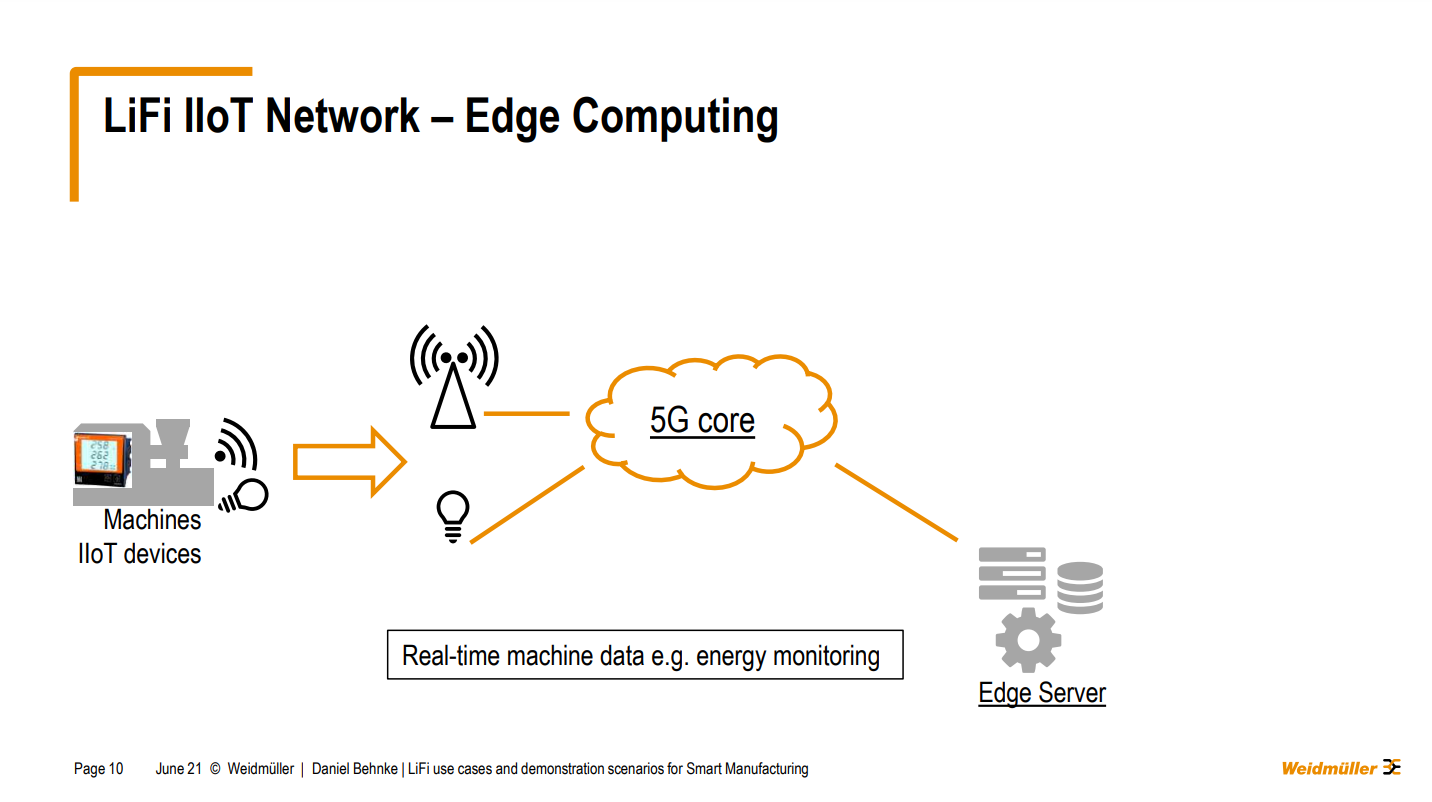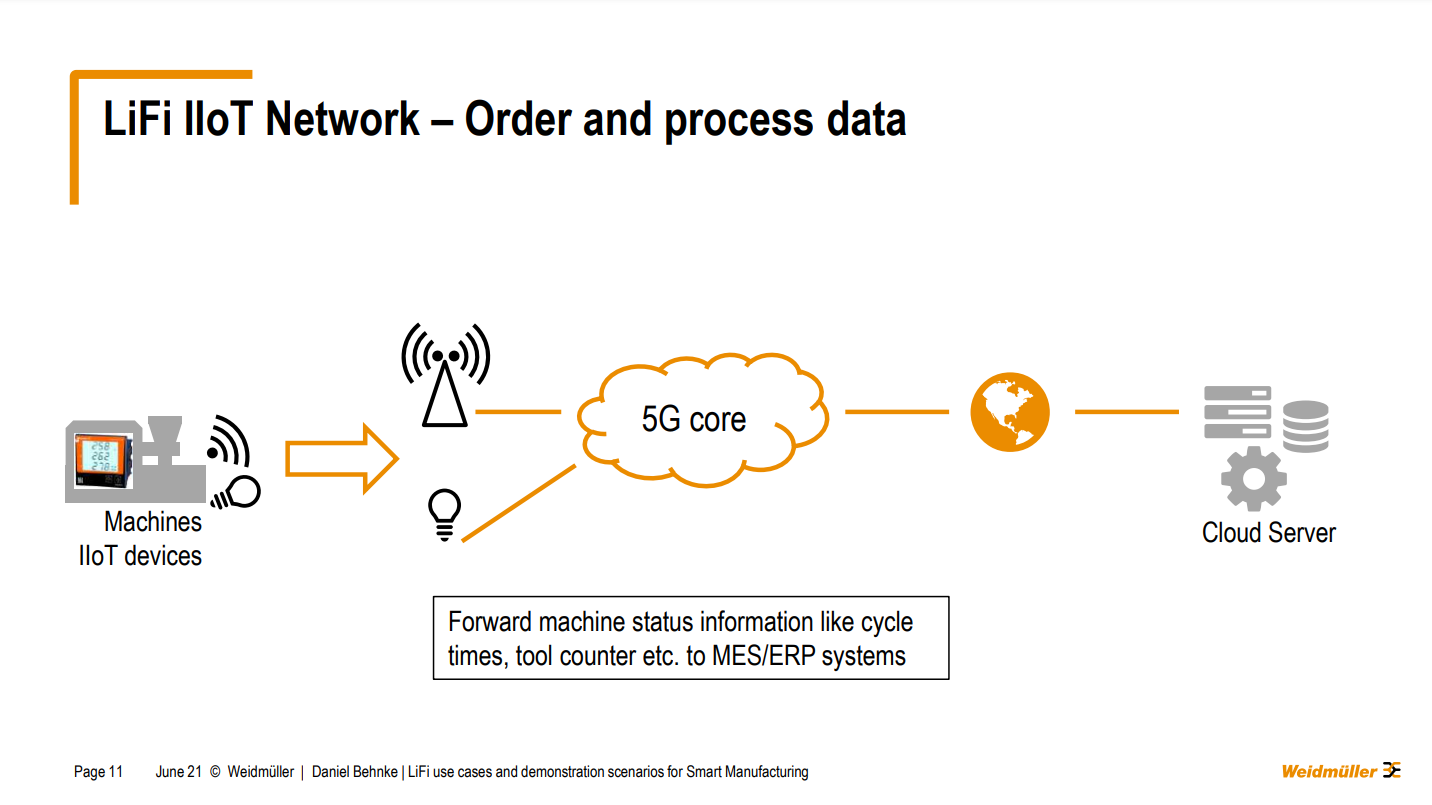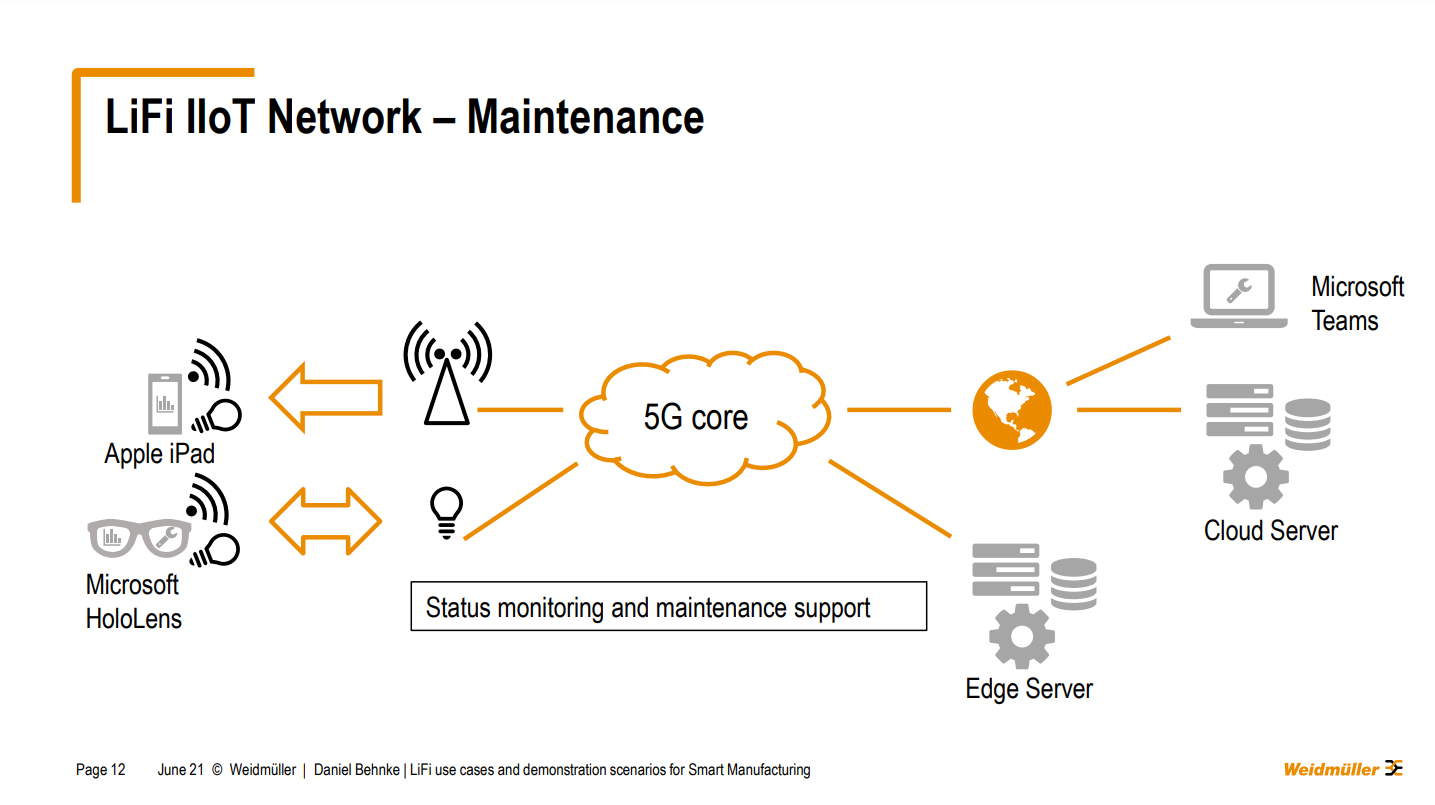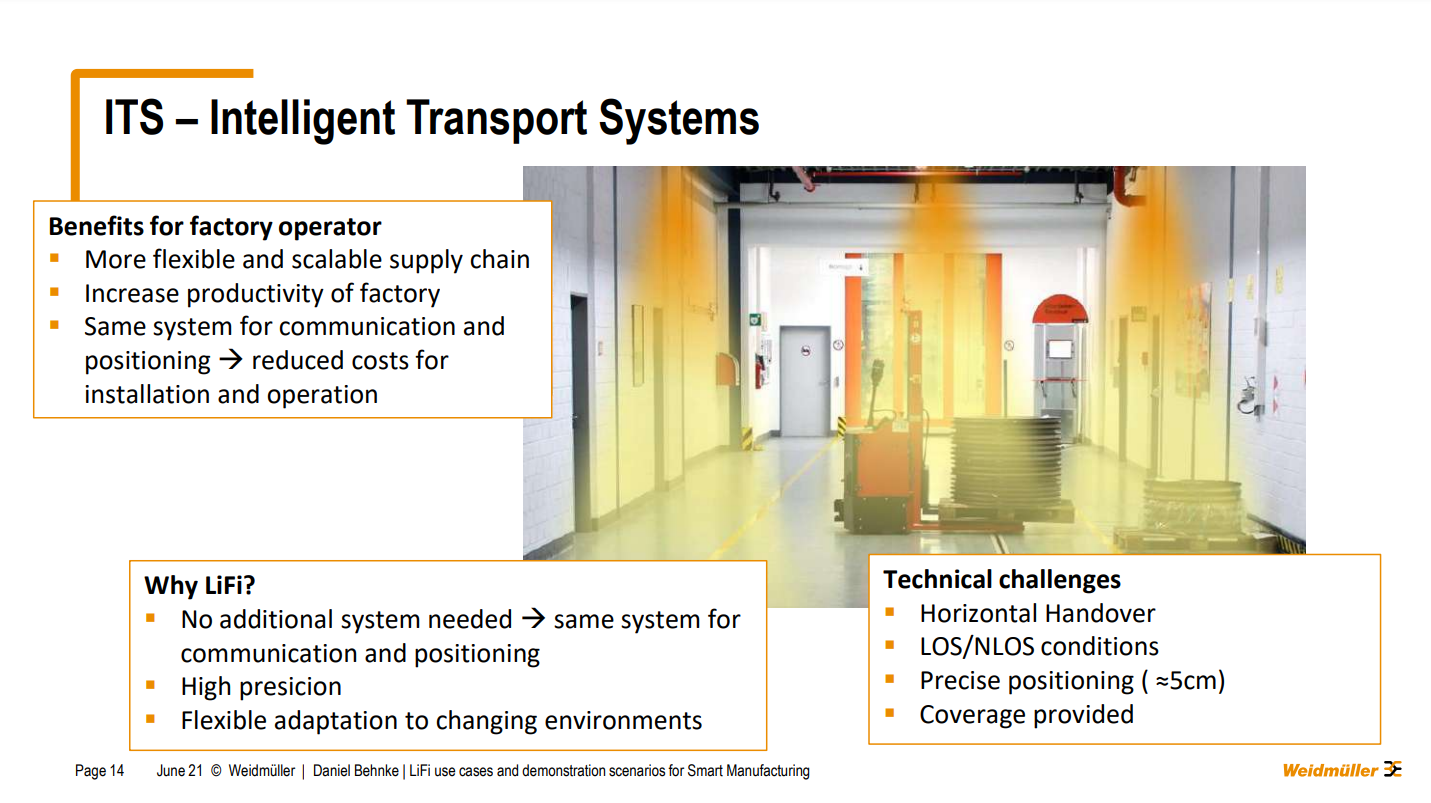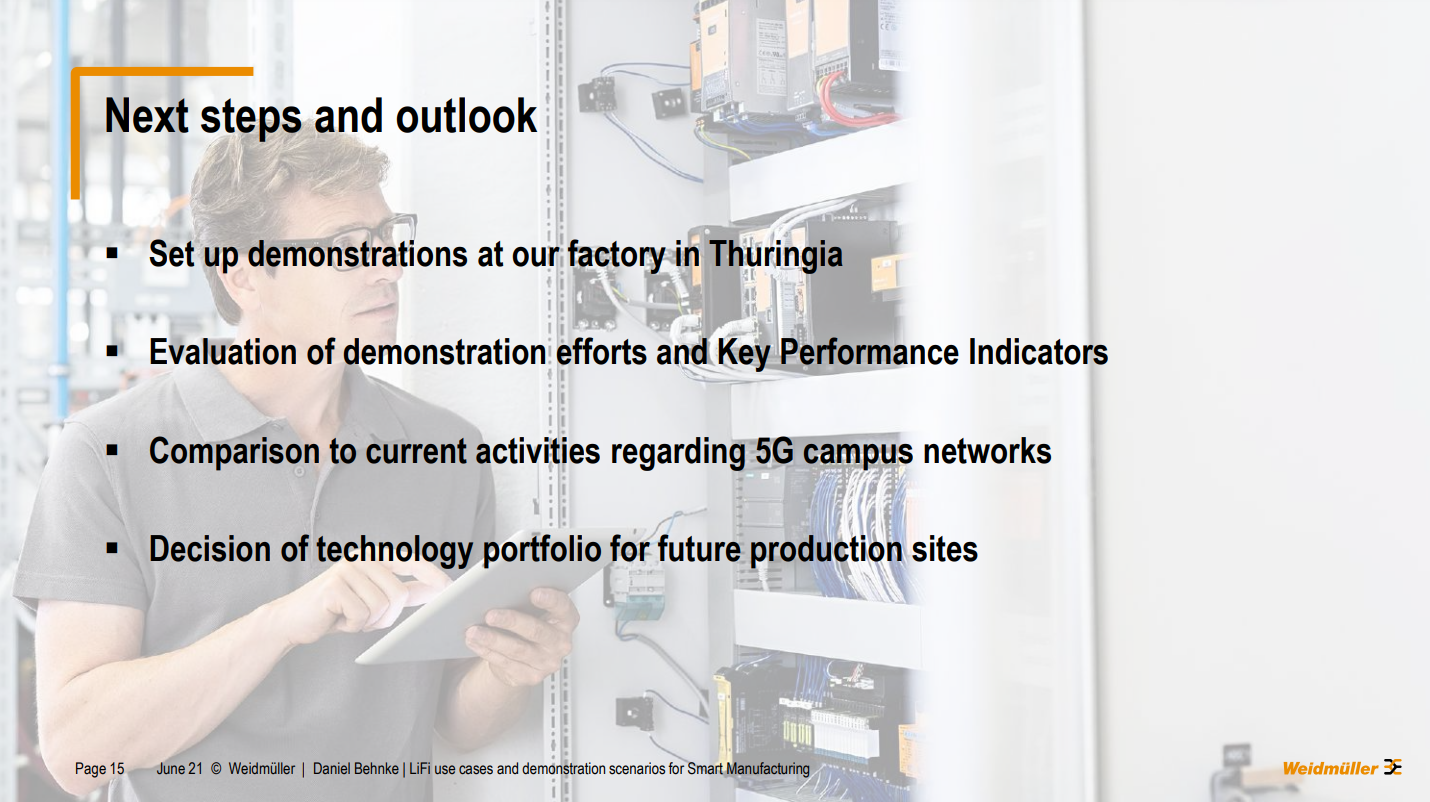Table of Contents
- Li-Fi Conference 2021
- Weidmüller Deutschland
- LiFi Use Cases And Demonstration Scenarios For Smart Manufacturing delivered by Daniel Behnke
- Weidmüller Group
- The Challenge in production is to drive efficiency and availability
- Understand your production to optimize the results
- EU Horizon 2020 project
- LiFi IIoT Network –Robust and reliable machine communication
- LiFi IIoT Network – Mobility support
- LiFi IIoT Network – Order and process data
- LiFi IIoT Network – Maintenance
- LiFi IIoT Network – Mobility and fixed positions with iOS devices
- ITS – Intelligent Transport Systems
- Li-Fi Conference 2022
- What is LiFi?
- How does LiFi work?
- LiFi Benefits
- LiFi Applications
- Subscribe to LiFi Tech News
Li-Fi Conference 2021 - Recap Part 5 - LiFi Use Cases And Demonstration Scenarios For Smart Manufacturing
Li-Fi Conference 2021
In our last article from our ONLINE Li-Fi Conference 2021 recap series, we discussed the presentation delivered by Nikola Serafimovski from pureLiFi on “Taking LiFi Mainstream”. The conference was organised by the Jakajima, the global High Tech Conference organiser, and the Light Communications Alliance.
Jakajima, Matchmaker for Innovators in the high tech industry, organises many events, ranging from LiFi Technology industry trends, 3D Printing to the Internet of Things, from Unmanned Cargo Aircraft to Health Tech, from 4D Printing to Photonics and from Vertical Farming to Sustainable Materials.
The online Li-Fi Conference included live presentations from researchers, executives and industry specialists from pureLiFi, Nokia, Signify, Orange, Radiocommunications Agency Netherlands, Velmenni, OLEDCOMM, HomeGrid Forum and Weidmüller Deutschland.
In another article recap series, we will talk about the presentation on LiFi Use Cases And Demonstration Scenarios For Smart Manufacturing delivered by Daniel Behnke from Weidmüller Deutschland. Before this, we will talk about Weidmüller Deutschland.
Weidmüller Deutschland
Weidmüller Interface GmbH & Co. KG is a German company in the field of electrical connection technology and electronics. Headquarters is in Detmold in the Ostwestfalen-Lippe region , in North Rhine-Westphalia .
The company has production facilities, sales companies and agencies in 80 countries. In the 2019 financial year, Weidmüller achieved sales of around 830 million euros. The company employs around 5,000 people worldwide. With its products, Weidmüller is mainly active in mechanical engineering, the process industry, energy generation and renewable energies, traffic engineering, building infrastructure and the area of device manufacturers.
The company has been working on the topic of Industry 4.0 since 2013. Weidmüller is involved in the leading-edge cluster it's OWL and numerous other research partnerships, such as the Robotisation Academy Foshan, the Smart Factory KL and the Centrum Industrial IT in Lemgo.
Along with Phoenix Contact and Harting, the company is one of the three major German connector manufacturers.
CA Weidmüller was founded in 1850 as a company in the textile industry by Carl August Weidmüller in Reichenbrand near Chemnitz. Gottfried Gläsel joined the company management as a partner in 1931 and became the sole owner and managing director in 1937. For reasons of recognition, the company name CA Weidmüller was retained. In 1943 the product range changed due to the Second World War. While searching for suitable products for his company, Gottfried Gläsel met Wilhelm Staffel, who was a development engineer at AEG and was involved in the development of the first automatic machine controls (e.g. for milling machines). The collaboration with Wilhelm Staffel leads to the production of the first "Staffelterminal ” for AEG in Berlin.
Reestablishing contact with Wilhelm Staffel in 1947 led to a contract that formed the basis for the reestablishment of CA Weidmüller in Berlebeck near Detmold in 1948. In the same year, production of the first plastic-insulated terminal block was started. In 1952, Weidmüller exhibited at the Hanover Fair for the first time. In the same year, the "switchgear row terminal" (SAK) was developed from thermoset plastics as the insulating material and a patented steel clamping yoke as the clamping system. According to the company, the terminal block was also a "best seller" at the end of 2018.
In the years after 1952, the company expanded its international activities and established itself in Europe, America and Asia. Weidmüller is now represented in over 80 countries worldwide. The locations include Germany, the Czech, Republic, Romania, China and Brazil with a production site and at the locations Germany, Spain, Australia, China, Brazil and Singapore with a development centre.
In 1959 the first foreign sales company was founded in England . Sales companies in Austria , France and Italy followed in 1967 . Spain joined in 1978, followed by Sweden and Belgium in the years that followed . With the founding of Thüringische Weidmüller GmbH in 1991, the company also expanded into Eastern and Central Europe. The youngest member of the group in Europe is the sales office in Switzerland .
1975 saw the expansion of activities to Brazil , Canada and the United States . The presence on the American continent was supplemented in 1994 by a sales company in Mexico . After the sales companies were sold, Weidmüller bought them back from the American company Rockwell Automation , Inc. in 2017.
In 1980, a sales company was founded in Japan , through which Weidmüller established its presence in Asia. A sales company in Singapore followed shortly afterwards . Since 1994, the company has also been continuously expanding its presence in China. Group companies and sales companies in Hong Kong , Shanghai and Malaysia complement the presence in the region. Today around 1,000 employees work at two locations and in 16 sales offices. Automation technology had already become the second mainstay in 1997, another area was interactive networking in production, building and energy technology.
The industrial site of Weidmüller Interface GmbH & Co. KG in Detmold-Berlebeck, built around 1950, was demolished in 2005.
In 2014, Weidmüller tried unsuccessfully to take over the family company R. Stahl , which operates in the field of explosion protection, under CFO Harald Vogelsang . Sales in the same year were 673 million euros; in Asia, it increased by around 120 percent after 50 percent in 2013.
Weidmüller offers specific solutions that manufacturing companies can use to prepare for the requirements of Industry 4.0. In 2013, Weidmüller presented a remote I/O system for the first time at the SPS IPC/Drives in Nuremberg, which has been continuously expanded. Since 2018, u-mation, an open, platform-independent automation kit, has made it possible to set up individual control solutions. With Industrial Analytics, Weidmüller also introduced software that enables predictive maintenance, predictive quality and new business models. Artificial intelligence and machine learning are used here.
LiFi Use Cases And Demonstration Scenarios For Smart Manufacturing delivered by Daniel Behnke
Daniel Behnke, Head of Global Digitalization/Corporate Factory IT & Technologies at Weidmüller Deutschland, was the fifth presenter at the online Li-Fi Conference 2021. He discussed in his presentation the LiFi Use Cases And Demonstration Scenarios For Smart Manufacturing.
Daniel Behnke worked as a research assistant at the Technische Universität Dortmund. Daniel went on to work at Weidmüller Deutschland as a smart factory digitalization engineer. He worked his way up to become a senior smart factory digitalization engineer and he is currently the Head of Global Digitalization/Corporate Factory IT & Technologies.
Below are some points discussed about the LiFi Use Cases And Demonstration Scenarios For Smart Manufacturing:
Weidmüller Group
Daniel started his presentation by saying the following:
“First of all, I want to introduce on just a few slides, what my vital areas of balance are what we are doing, so you get a better perspective of why we are dealing with different communication technologies. So, Weidmuller is an expert and transmission of power signals and data. And that's real environments. And, of course, we have launched our product portfolios. As you can see here, we've been starting with Terminal Blocks 70 years ago now. Then after a few years, we added also connectors for different kinds of cables that are needed. So here, for example, recent, but of course, also digital and analogue I O. I, for my third, I'm working at the factories of Europe. So I'm not part of the product development department. But we are also having several large production sites all over the world. For us, it is the opportunity to think about better solutions for our production, and how we can get better, make them more efficient, and so on in the future. As you can see here, also on the right side, we are at the moment, not just talking anymore about just pure hardware components, but also about software components. That's on the 100% for us, for our customers. But of course, that's also very interesting for us at our own production sites”.
”I've talked about our production sites on a worldwide level to here you can see the map where you can find more, I think your company is not so well known as for example, Signify what we've heard before. But our customers are generally in the business market. So we are not selling to private customers directly. Our company's headquarters here in Germany and that mode where I'm at the moment and I want to talk about a little bit about our production site in the eastern part of Germany, where we are doing some use cases and demonstrations regarding LIFI technology”.
The Challenge in production is to drive efficiency and availability
“So, why we are talking about different communication technologies. So, it's not that might be not that obvious, why we have some factory IT dealing with production sites here directly involved and also research regarding LIFI communications. So, in general generally what drives us is we want to increase of course, wearability and productivity of all our production sites, we want to increase the process efficiency and yield and also, we want to have better efficiency regarding energy and resources. resources, for example, at the moment is a very huge topic at our company. As maybe some of you are also experiencing at the moment that resources are very limited. And we have issues to continue our production at some times. And all of that lead source to a situation where we are talking about new IT technologies. For example, we want to integrate industrial IoT sensors, and things like that, and are also talking about automation many, many times where we also need communication technology. But in general and important aspect, stressing that many many times also in our research projects. For us communication technology is a servant, that's not a driver. So we are very open-minded regarding all communication technologies and want to see what fits the most for us.”
Understand your production to optimize the results
“What kind of channel advantages do we see in the upcoming future. As I've mentioned, the number of sensors and actors that are increasing at the moment and will be much more in the future. We want to have a lot of data from all our machines and ultimates. Because we want to analyse them, we want to see what we can do better than we are doing at the moment. And therefore getting a lot more information will reduce the time to act, if we see some issues with some machines. And therefore at the end of the day, we also need the real-time analysis of our production states.”, said Daniel Behnke.
EU Horizon 2020 project
“What kind of channel advantages do we see in the upcoming future. As I've mentioned, the number of sensors and actors that are increasing at the moment and will be much more in the future. We want to have a lot of data from all our machines and ultimates. Because we want to analyse them, we want to see what we can do better than we are doing at the moment. And therefore getting a lot more information will reduce the time to act, if we see some issues with some machines. And therefore at the end, we also need the real-time analysis of our production states”.
“To get in touch with LIFI technologies, we are in the lucky situation that we are part of the EU Horizon 2020 project named ELIOT, where we can evaluate the use of LIFI by communication for smart manufacturing for us. What we are doing in this project is on the first-hand where I've been talking a lot about potential use cases. I will talk about that on the next slides. And we want to set up demonstration cases, to see how the technology works firsthand. We want to see them working in our factories and our production sites. And yeah, that's what we want to do our daily activities. Our main questions are, for example, is there sufficient coverage for all our machines? How many luminaires do we need at the end? Is the reliability better than Wi-Fi provides for us, we all know Wi-Fi peripheral technology but has some flaws at some times. But also we have to keep in mind the costs from for the different technologies. So for example, we are using Wi-Fi, you will see that on the next slides. Also, another factor is at the moment and working environment. But we see some issues over there. And the question for us is will LIFI be a benefit for us keeping costs and performance in mind. And also what are some very interesting topic, for the whole industry, our 5g campus networks, we are also involved in another 5g research project where we want to evaluate exactly the use of 5g over there. What's also very interesting and important for us at the end to evaluate the different technologies and our Setup and Maintenance efforts. So what we want to see not just what the investors want but also what are the costs forum for the next year's forum. Unfortunately, we wanted to be more at the demonstration phase at the moment but due to COVID-19, we weren't able to have any visitors and our production sites in the last month. So we couldn't set up the demonstrator, we will do that now in the fall. And at the moment we see the end of this project and of the year. Maybe it changes a little bit”.
LiFi IIoT Network –Robust and reliable machine communication
“But let's talk about the use cases. So, we see three or four different use cases I want to introduce shortly. First of all, we have seen the industrial IoT network. So we need robust and reliable machine communication. For example, we want to transmit camera information for quality checks, present formation and things like that. And also, of course, energy from the energy monitoring work that we can increase our data transparency. We want to save efforts of maybe cable installation because we have a faster setup time for new machines and but also we want to have a look at technical challenges. So how to connect all the industrial IoT devices”.
“I was listening very carefully to Nikola's talk beforehand because that's, that's the most important aspect at the end. So what kind of end-user devices will be available for, LIFI communication. And also, if we want to talk about full automation at the end, we have to have very low latency.”
LiFi IIoT Network – Mobility support
“What we are also examining and Elliott is the mobility support with the integration of LIFI into the 5g core. There, we are working together on the phone over-focus. And there were talking about different use cases, integration of more devices. I want to stress that a little bit more on some detailed slides. So first of all, as I've mentioned before, we want to directly interconnect the machines, we can do that either via LIFI or via 5g and maybe have some kind of edge server cluster onto the machines for real-time and machine data analysis”.
LiFi IIoT Network – Order and process data
“Then, we also want to forward this data information to MDS or ERP systems. We want to inform our information like cycle times to a counsellor, etc, maybe to a cloud system could be also on intranet system”.
LiFi IIoT Network – Maintenance
“For the iPad, that's mentioned here and done the Microsoft HoloLens we see the status monitoring and especially maintenance support. We are heavily using the Microsoft HoloLens at our production sites to support if there's an issue and also to set up new machines that have been developed here in Germany and are now operating for example, in Romania. And during the last month where we weren't able to travel, we did that with the Microsoft HoloLens and also with that, with that, we need a word reliable communication technology”.
LiFi IIoT Network – Mobility and fixed positions with iOS devices
“I want to show you some pictures. So, you get a better impression of what we foresee as use cases. For example, here for the iOS devices also from a mobility perspective, there were, for example, the icons, which we are using for confirmation of production parts. In the demonstration scenario for ELIOT, we will integrate those devices via 5g because they are we have mobility support everywhere and the factory. And we have also foreseen switching to the iPad. And data offloading scenario when we are close to our machine where we have a LIFI link available, then we can hand over the communication from 5g to LIFI to get some more information. But also we are using mobile devices such as an iPad on fixed positions, for example, here at the machine where we are doing all the different aspects regarding our manufacturing execution system. So, set output times will be monitored over there as well as order confirmations as well. quality checks, things like that. And for that LIFI integration would be very helpful for us because these iPads are at the moment connected via Wi-Fi. And, and generally, it's working, but it's working, I would say 95% and we want to have it somewhere above 99% of the time. But also you can see here in challenging environments because of course we have to keep the iPads in a robust case. So also there. That would be an interesting aspect of our discussions”.
ITS – Intelligent Transport Systems
“And we have another use case that's regarding positioning, we are using intelligent transport systems. You can see here a picture from our factory and we want to use much more in the upcoming future with enhanced automation. And automated logistics becomes also a very important topic in the next years. And there, we need a very high precision up to a few centimetres. And yeah, we are very interested to see how the technology is working in that regard”.
“With that, I want to conclude my tour. Unfortunately, I am not able to show you any results at the moment, because we are not in the phase where we could have set up the demonstrations. We will do that in the upcoming month and maybe end of this year or startup next year. We also have some results regarding our use cases. So our next steps are, we want to set up the demonstrations. And then we want to compare the technology, for example, adding 5g campus net networks. So at the end of the project, ELIOT, that will be the decision for us. And that's our aim and our goal. If LIFI is interesting technology and will be also part of our future strategy regarding future production sites, or why Wi-Fi and 5g are the benefits for us and we will focus on that communication technologies”.
You can also watch the full video presentation on the following YouTube link from Jakajima YouTube channel.
Li-Fi Conference 2022
The next Li-Fi Conference is coming up on the 28th of June 2022 between 10 am and 4.30 pm CET.
It is interesting to realise that lights that illuminate offices, homes, cars, factories, our streets and more locations also can connect us to data and hence power the growing demand for connectivity and speed.
At this conference professionals from all over the globe will gather together in order to share applications, ideas, new developments and ways to integrate Li-Fi in services, both for consumers and professionals.
This conference will be held Live and Online. The venue will be the High Tech Campus 1, The Strip 5656 AE Eindhoven The Netherlands.
Online tickets can be bought at the following link:
https://tikcit.com/register/61e002336d7fc4b6745cab83/
What is LiFi?
LiFi, also known as "Light Fidelity" is a wireless optical networking technology, which uses light-emitting diodes (LEDs) to transmit data. In 2011, professor Harald Haas made a LiFi demonstration at the TED (Technology, Entertainment, Design) Global Talk on Visible Light Communication (VLC).
VLC uses light as a medium to deliver high-speed communication like Wi-Fi and complies with the IEEE standard IEEE 802.15.7. The IEEE 802.15.7 is a high-speed, bidirectional, and fully networked wireless communication technology-based standard similar to Wi-Fi's IEEE 802.11.
How does LiFi work?
LiFi is a high speed, bidirectional, and fully networked wireless communication of data using light. LiFi constitutes of several light bulbs that form a wireless network.
When an electrical current goes through to a LED light bulb, a stream of light (photons) emits from the lamp. LED bulbs are semiconductor devices, which means that the brightness of the light flowing through them can change at extremely high speeds. The signal is sent by modulating the light at different rates. The signal can then be received by a detector that interprets the changes in light intensity (the signal) as data. Also when the LED is ON, you transmit a digital 1, and when it is OFF, you transmit a 0.
LiFi Benefits
The primary benefits of LiFi are as follows:
• Security: Provides entirely secure access. Where there is no light there is no data.
• Safety: Does not produce electromagnetic radiation and does not interfere with existing electronic systems.
• Localisation: Allows localisation due to the small coverage area of LiFi access point - localisation can be used for very precise asset tracking.
• Data density: Provides ubiquitous high-speed wireless access that offers substantially greater data density (data rate per unit area) than RF through high bandwidth reuse.
Credit to Oledcomm
LiFi Applications
LiFi can be used for so many applications and the list is increasing every year. You can read our updated list of Li-Fi applications at the following link:
Credit to pureLiFi
In conclusion, if you are also interested to hear more information about the OWNII Coin or enquire about LiFi devices such as the LiFiMax and Trulifi, you can contact us through our chatbot or by sending an email through our contact us form. If you enjoyed this post and would like to hear more updates about LiFi technology, subscribe to our newsletter. Don’t forget to subscribe to our social media accounts. You can also join our Telegram group about LiFi technology on this link:
https://t.me/joinchat/FMzOmsEKyJFrU6Af
